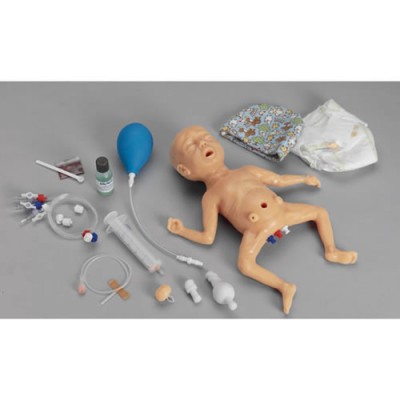- 50% SALE
- Dental
- Midwifery
- New Products
- Anatomical Models
- Birth Sets, Dolls & Pelvis
- Brains and Heads
- Circulation
- Digestion
- Ears and Senses
- Excretion
- Eyes
- Hands and Feet
- Heart
- Individual Bones
- Infections and Illnesses
- Larynx
- Mammary Gland
- Muscular Models
- Nails
- Nerve Models
- Obstetrics
- Pelvis Reproduction
- Reproduction
- Respiration
- Skeletons
- Skin
- Spinal Cord
- Teeth and Jaws
- Torsos
- COVID
- Budget Models
- Charts & AV
- Manual Handling
- Medical Models
- Medical Simulators
- Osteology
- Veterinary
- Plant & Animal
Micro-Preemie Simulator - White
Nearly one out of every eight newborns arrive prematurely. To help you give your tiniest patients the best care possible, Nasco is proud to introduce the Micro-Preemie. This 25-week ELBW (Extremely Low Birth Weight) neonate is the smallest and most realistic pre-term infant available. Invaluable for training nurses and parents in care and handling techniques for babies that have had multiple medical interventions; the perfect team training aid for multiples or other high-risk delivery and transport scenarios. The baby can be ventilated and will accept a functional ET tube, NG tube, umbilical catheter, and IV line, as well as a non-functional chest tube and stomas. Detachable neural tube defect and omphalocele. Includes diaper, hat, lubricant, 3 cc syringe, 25 G. butterfly needle and blood powder. Hat color may vary. NG tube size 5 FR. ET tube size 5 mm ID. Simulator dimensions: 12" long, 4" deep, and 18-1/2" across from hand to hand.
Features and Functions:
• Breathing - pulse bulb to manually simulate breathing rate volume.
• Ventilation - molded-in lung produces a visible chest rise when ventilated by mouth; trachea and pharynx are not anatomically correct, but will accept a functioning endotracheal tube.
• GI - one nostril will accept a functioning NG tube (tube passes through the body and liquids will either drain away from the body or into the diaper); optional stoma can be plugged into a permanent site on the abdomen.
• Umbilicus - soft, lifelike umbilicus has a patent vein and two arteries; umbilical stump functions like a cork, plugging into a small cavity molded into the abdomen (cavity can be used as a reservoir for blood drawn through a catheter or to receive fluids and the drain exits from the diaper area); a separate umbilicus represents an optional omphalocele.
• IV Access - several typical sites have embedded tubing that can accept an IV catheter; one is functional, allowing the administration of fluids, which will drain from the diaper area.
• Chest Tube - a permanent site in the baby’s side accepts a nonfunctioning chest tube.
• Neural Tube Defect (Myelomeningocele) - An optional structure representing an open neural tube defect can be inserted into the back.
• Various monitors, sensors, electrodes, etc., can be attached to the manikin wherever needed.






